Mars at Opposition July 27, 2018
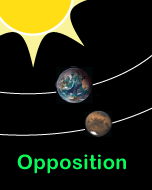
The best time to observe Mars is when it is on the opposite side from the Sun as viewed from Earth as it will be on the night of July 27, 2018. The disk of Mars will be 23.8" and shine at -2.8 magnitude. Ordinarily Mars can be a difficult object to find in the night sky,when it hides behind the Sun, skirts the horizon, and appears only as bright as a second magnitude star. Every 780 days, or roughly 2 years and 50 days, planet Earth passes Mars on its orbital track, overtaking the red planet. Opposition occurs at the moment Earth overtakes Mars. At that time, Mars will be seen all night after the Sun sets and present a full disk until dawn.
The Earth's orbit is very nearly circular, but Mars' orbit is more eccentric, that is, it varies 0.093 from circular. This means the red planet is much closer to the Sun at perihelion (206 million km) than at aphelion (249 million km) a difference of 43 million km. In comparison, the difference between Earth's aphelion and perihelion distance is 5 million km. These distances vary, of course, and I have used extremes. But those differences mean the distance between Earth and Mars at opposition is variable. The count of 780 (actually 778 days) is considered Mars' "synodic" period.
When Mars emerges from conjunction and becomes visible again, a new march toward opposition begins. As soon as Mars can be observed in the morning sky, astronomers call that observing period an "apparition." The 2018 apparition of Mars will continue until once again the red planet disappears behind the Sun in September 2019.
Next Opposition: October 13, 2020
Perihelic Opposition
The July 27, 2018 opposition of Mars will be one of the best oppositions because it takes place when Mars is close to the apside or point of perihelion in its orbit and is called a "perihelic" opposition . With the regular orbits of Earth and Mars, oppositions occur in cycles of 7 oppositions over a period of 15.8-years. When the cycle has completed 3 times (after 237 or so years) the cycle resets and replays when the planets again reach opposition at very similar positions. Because of the speed of their orbits Earth travels for 2 years, plus an extra 50 days or so when it catches up again with Mars.

The Earth/Mars opposition cycle can be seen in the diagram. The 2018 opposition is shown at the lower right, represented by the disks of Earth and Mars. The image shows the solar system as though we are looking down on the Sun's north pole. Although the orbits are shown here with some accuracy, the images of the Sun, Earth, and Mars are not drawn to scale. Both Earth and Mars are shown with the north pole tipped toward the Sun. Future oppositions are represented by blue and red dots. The orbits are both marked with apsides (a=aphelion and p=perihelion) and the first point of Aries. This marks the 0-degree point for RA in Earth coordinates and therefore helps to orient the orbit.
As can be seen, Mars will be still approaching its perihelion on July 27, so it will be closest to the Earth on July 31, a little more than 4 days later. After that, the Earth will speed away from the red planet, only to meet up again in 2020. When perihelic oppositions occur, they all have similar characteristics. Because the Earth's north pole is tipped toward the Sun the perihelic opposition will always be more favorable to earth-based observers in the southern hemisphere. In 2018, Mars will be at -25 degrees in Earth's sky and will appear very low to those north of the equator. Mars is also inclined to its orbit, its axial tilt is 25.2 degrees and it will be pointing its southern hemisphere toward the Sun during perihelic oppositions. Mars' orbital motion near perihelion is faster than at aphelion so there is a greater distance between perihelic oppositions as compared to aphelic. Mars' orbit and axial tilt means that southern summers are shorter and hotter than southern winters. The seasons are not equal: summer in the north lasts 182 days, while southern summers are 160 days. Because the south pole is easier to see at perihelic passes, it was better mapped and known before the space age. The seasonal differences mean that Mars north polar cap is larger than the southern cap that may disappear completely during the summer months. The seasonal differences on Earth are balanced by the large oceans and in any case are not as great since its orbit is more circular.
Mars Special Tricks around Opposition
One of the biggest problems the early western astronomers faced, was how to fit the odd behavior of the outer planets into their earth-centered universe. Planets were called "wanderers" because they could be seen in every constellation that was located on the ecliptic. The ecliptic is actually the plane of the Earth's orbit in space. The constellations that occupy the ecliptic are really on a line-of-sight from the planet. They are frequently called "zodiac constellations" but in the parlance of astronomers they are ecliptic constellations.
Today zodiacal designations are astrological. In astronomy, ecliptic constellations occupy the amount of the degrees in the sky that they cover on the ecliptic path. Constellations are set by the International Astronomical Union (IAU) dividing the sky so that we are all on the same page when it comes to naming or pointing at a location on the celestial sphere. There is also precession or the "wobble" of Earth on its axis, pointing at different stars on the celestial sphere; that astronomy takes into account. Earth and Mars have different pole stars. Astronomical charts are prepared by epoch that changes every 50 years. We are currently using Epoch 2000.
The ecliptic is the area of the sky where the Sun and the Moon are seen regularly; when the Earth is included, this is where eclipses occur. All the planets orbit the Sun close to its equator, basically making the solar system flat rather than spherical. In our geocentric view, the apparent orbits of the planets are held to Earth standards in that we are comparing their orbits against our own. Because the solar system is rather flat, most planets are within 3 or so degrees but Mercury is a bit more at 7 degrees. The Moon is inclined at 5 degrees to the ecliptic. The inclination difference affects how we see objects in the sky. The five degrees for the Moon means it has a 10-degree path through the ecliptic. That causes a regular 18-year cycle where the Moon hits its extremes. Planets move up and down on the ecliptic based on nodes in their orbits--that is where they are crossing the ecliptic and moving north or south. Earth's orbit also has its ups and downs but we are holding our orbit as a standard.
Mars' inclination to the ecliptic is about 1.85 degrees. You may find the ups and downs marked on some orbit diagrams like the one above but this one does not have them. They are marked with an omega-like symbol with curls at the bottom for ascending node ☊. It is turned upside down for descending node ☋. As Mars goes about its orbit, it appears to move through the constellations on the ecliptic in a regular pattern from West to East. This is contrary to the motion of the stars that move from East to West as the Earth rotates. So during the months around opposition, Mars becomes bright, calling attention to itself for astronomers or anyone looking up who can see that bright red warrior. At first it seems to behave as usual, but then it does a little dance, and starts to move in the opposite direction or retrograde motion.
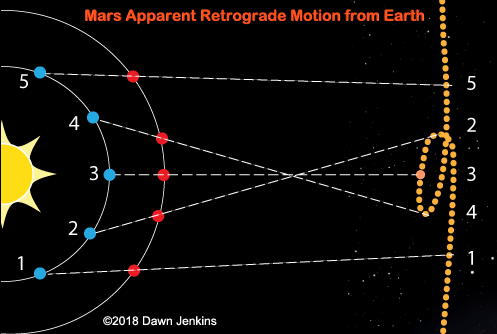
Before retrograde motion begins, Mars seems to stand still. This can be thought of as Earth, coming around the curve of its orbit so that Mars appears to quit moving. This is merely our line-of-sight. It's like being on a train when it is being passed by a faster train. If you are looking out the train window, suddenly you feel like you are moving backwards. Earth and Mars are doing something like this, the blue planet is lapping the red planet on their orbital tracks. Just before the July 27 opposition, on June 28, Mars hit its first stationary point. After that it travels in a backward direction (East to West) until August 28 when it hits another stationary point. After that it resumes its normal course, although it has never done anything but continue to revolve in its usual orbit. It is only our line-of-sight that makes it seem to move in a loop or sometimes an ess-curve against the background stars.
The diagram shows how this works. Earth position is marked in blue and the Mars position is marked in red. An observer on the Earth looks at Mars when they are located at the 1 position. The Earthling sees Mars against the star background moving in its usual prograde motion from west to east. A short while later both Earth and Mars arrive at the second position, Mars appears to stand still and retrace its steps. At position 3, the observer is treated to the happy circumstance of Mars at opposition. The Sun is behind the Earth. Mars spends all night in the sky, on July 27 the disk will be 24.3" in diameter. At position 4, the Earth observer sees that Mars is stopping and returning to its normal contrary motion moving from west to east against the background field of stars. At position 5, Mars has been left behind and both planets orbit the Sun until their mutual speeds and positions reunite them for the next opposition. The disk shrinks and will continue to do so until Mars disappears behind the Sun in September 2019.
Mars path through Capricornus 2018
In 2018, Mars moves through the constellation of Capricornus. As viewed from Earth, a loop through the constellation occurs as Mars appears to move backward, that is from East to West.
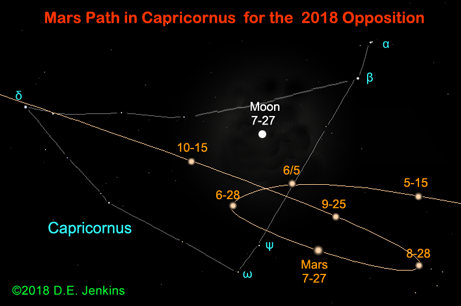
Earth and Mars Comparison
Although Earth and Mars share some similarities, they also have many differences. They are both members of the inner solar system that consists of five planets. The accepted outer planets in the solar system are gas giants, but Earth and Mars have rocky surfaces that can be walked on. They are both inclined to their orbits that causes seasons that are similar, but still different.
Mars is about half the size of Earth, with a gravity at the surface that is 1/3 the amount of Earth's. At the surface of Earth, the atmosphere exerts a tremendous pressure to which human beings have been adapted. On Mars there is no such pressure, so the blood in human veins and arteries would just boil away. In no case will humans exploring Mars ever be able to remove their space helmets, no matter how many movies Hollywood makes that say differently. Mars is so small that it could not hold on to liquid water at the surface. Whatever water may have been there in the past has long since boiled away and left Mars' atmosphere. Only water trapped in ice and beneath the surface may have been able to remain on Mars intact.
| Characteristic | Earth | Mars |
|---|---|---|
| Diameter | 12,756 km | 6,792 km |
| Orbital period (sidereal) | 365 days | 687 days |
| Revolutional period | 23:56:4 | 24:37 |
| Axial Tilt (inclination) | 23.4 deg | 25.2 deg |
| Distance from Sun (average) | 149.6 million km | 227.9 million km |
Mars is devoid of any water on the surface in a liquid state while the surface of Earth is two-thirds water. Mars' atmosphere consists of 95% carbon dioxide, 2.7% nitrogen,and only traces of oxygen, argon, and carbon monoxide. Earth has a mixture of 78% nitrogen, 21% oxygen, and traces of other elements in its 5-layered atmosphere. Mars has dust storms that can cover the entire surface, filling its meager atmosphere with particles. Earth has a complex water cycle where clouds grow and rain falls to the ground. Dust particles in a Mars storm settle out gradually. Mars does have some clouds made of carbon dioxide and perhaps water crystals. They appear sometimes around the giant volcanoes and in the morning sky. Another key difference between Earth and Mars is albedo. Mars albedo is .15, meaning that 15 percent of of the light that falls on it from distant Sol is reflected back into space. Thirty-one percent of the light that reaches Earth is reflected back into space. Earth's appearance is blue and white, due to water, while the land masses occasionally poke out between the clouds. From a distance planet Earth appears bright with a moon that doesn't stray far from its primary. Both planets have ice caps; Mars caps disappear during the Summer while Earth's ice cap in the north only recently began melting during the Summer.
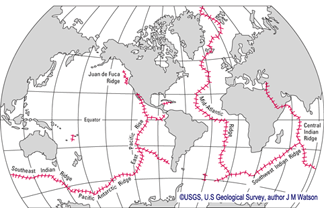 Earth has a complex crustal surface, with continents drifting on the mantle, the central core being liquid iron. The largest feature on the planet is the mid-oceanic ridge that wraps around the entire planet like stitches on a baseball. It cannot be detected from space at visible wave-lengths due to the water that covers Earth's trenches. Nevertheless, this is the largest crustal feature of the planet. Earth has a complex magnetic field that produces the Van Allen Belts protecting inhabitants from dangerous light wavelengths. Mars magnetic field can be detected at certain locations suggesting there once may have been a planet-wide field. Mars has a mysterious crustal dichotomy as the northern hemisphere is very flat, flatter than Earth's ocean floors, while the south hemisphere is at a higher elevation, pocked with craters. It may be that a giant impact produced the northern smoother surface.
Earth has a complex crustal surface, with continents drifting on the mantle, the central core being liquid iron. The largest feature on the planet is the mid-oceanic ridge that wraps around the entire planet like stitches on a baseball. It cannot be detected from space at visible wave-lengths due to the water that covers Earth's trenches. Nevertheless, this is the largest crustal feature of the planet. Earth has a complex magnetic field that produces the Van Allen Belts protecting inhabitants from dangerous light wavelengths. Mars magnetic field can be detected at certain locations suggesting there once may have been a planet-wide field. Mars has a mysterious crustal dichotomy as the northern hemisphere is very flat, flatter than Earth's ocean floors, while the south hemisphere is at a higher elevation, pocked with craters. It may be that a giant impact produced the northern smoother surface.
Another unique Mars feature is the Tharsis Bulge, a volcanic region that is elevated above the average surface by 9 km. The region is over 1800 km across. This is where Mars keeps its giant volcanoes. Olympus Mons is the largest at 624 km or 374 miles in diameter. It has an elevation of 25 km or 16 miles high. The Tharsis ridge includes 3 giant volcanoes Ascraeus Mons, Pavonis Mons, and Arsia Mons.(And many more as well.) Earth's highest mountain, Everest at 8.8 km, is 5 km shorter than Elysium Mons (13,862 km.) that is not as high as any of the 3 volcanoes on the Tharsis Ridge. At the eastern edge, a huge canyon known as Valles Marines is almost certainly formed by the same forces that built the Tharsis region. All this volcano building caused the crust to split open. Valles Marines, discovered by a space probe, is 4,000 km or 2,500 miles long. Earth's Grand Canyon in N. America is 446 km or 277 miles long, up to 29 km (18 mi.) wide and over a mile in depth (1,857 m or 6,093 ft.)
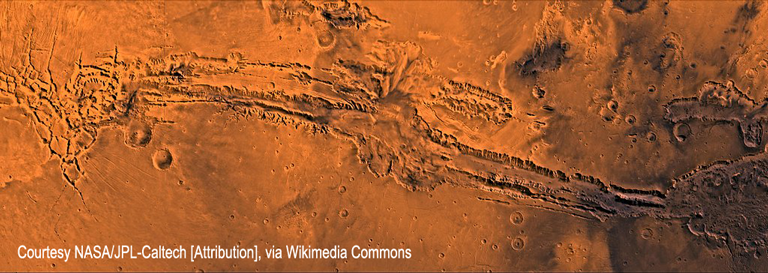
The deepest feature on Mars is the gigantic crater Hellas Basin at -7,152 km elevation. Earth can boast of the deepest trench in the solar system, at the southern end of the Mariana Trench, Challenger Deep at -10,924 km below sea level.
Mars Disk Comparison
The first disk of Mars on the chart below represents the size and magnitude of the disk of Mars when it is not heading for an opposition. This tiny disk may represent the view of Mars when it is far from Earth. When far out there the planet Mars presents a small disk, not quite 4 arc-secs in diameter. It will shine at 1.6 magnitude or somewhat less. This is equivalent to the appearance of Alioth, the first star in the handle of the Big Dipper, close to the bowl. As you can see a star as faint as this could really get lost in a bright star field or close tothe horizon before sunrise or after sunset. This is when I really see the planet displaying a deep red color.

How dramatic the difference is shows emphatically when placed next to the apparent disk of Mars at the 2018 opposition when the planet is at closest approach. For the next 15 years, the disk of Mars will never grow to such impressive size or magnitude. When observing solar system planets, make no mistake, bigger really is better. Resolution is improved when the planet is closer to Earth, rather than far away. The larger the aperture of the telescope the better Mars can be seen and for orbiting instruments placed high above the Earth's atmosphere, so much the better to view that far away red dot. And how far away Mars can really get! When Mars is far away it can be up to 401 Mkm distant. Compare that number to the 2003 Opposition close approach at 55,758,006 km and realize that Earth pulls away from Mars after every opposition.
Communications that take 3 minutes to travel to Earth when Mars is close compared to 22 minutes it takes to get to Earth when Mars is far away. Waiting for a return message is equally time consuming. There is just no shortcut with our current technology. In addition, if Mars is hidden by the Sun, there will be no communications until the planets once again have a line-of-sight.
The apparent Disk of Mars at the time of opposition, generated using the US Naval Observatory's Apparent Disk of Solar System Objects tool. Details for using this great web app are below. When Mars is at opposition in 2018 this is what the disk will apparently show. It seems that Valles Marines will be hogging the show.
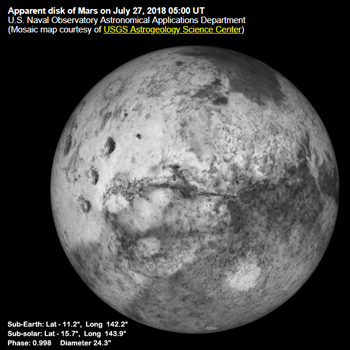
Some helpful links
Find out which side of Mars is visible while you are out viewing the red planet through a telescope. Sky & Telescope magazine features an interactive application, Mars profiler. Use this tool to find out what side of the martian surface is currently in your viewfinder or check up on the time of your observation.
I have trouble imagining the Mars disk with the Mars profiler or the large map in my den, so I go to this site to find out what part of the disk is showing.
Apparent Disk of Solar System Object - US Naval Observatory
Rise/Set/Transit Times for Major Solar System Bodies and Bright Stars - You can always use this page at the US Naval Observatory to find the rise and set times of solar system objects from your location.
A.L.P.O. MARS Section - American League of Planetary Observers
B.A.A. Mars Section - British Astronomical Association
Hubble Space Telescope Images of Opposition 2018
Mars in opposition in 2018 (annotated) - Labels features visible shortly before opposition through dust storm
Stormy Mars in opposition in 2018 - About 2 weeks before closest approach
Mars 2016/2018 side-by-side - Show how different Mars looked in 2016 from 2018 due to dust storm andMars-Earth circumstances
Animation of difference in Mars orientation, 2016 and 2018 - This shows how different seasons on Mars change the planet's appearence for Earth observers. Because the south pole is pointing toward the Sun, Hellas Basin can be seen more clearly during perihelion aparitions.
One last image that I really love because Saturn was at opposition a month earlier than Mars. The year 2018 brought 3 oppositions in quick succession including Jupiter at opposition May 9. This image shows that Hubble Space Telescope is a planetary instrument as well as a deep sky marvel:
Next Opposition: October 13, 2020
For more observation tips go here to last month's What's up article/observingMars.
For drawing help go here to last month's What's up article/drawingMars.
To find out about Earth's missions to Mars, go to Astra's Mars Exploration page.
If you love the red planet as much as Astra does, check out the Astra's Stargate 3 Faces of Mars page!
